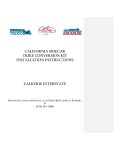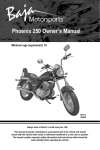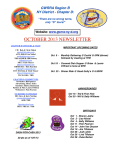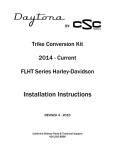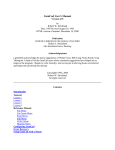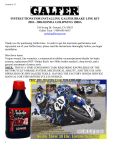Download COBRA or COBRA XL - California Sidecar
Transcript
Cobra & Cobra XL by Trike Conversion Kit 2001 - 2010 GL1800 Goldwing Installation Instructions REVISED 1 - 2015 California Sidecar Parts & Technical Support 434.263.8866 Table of contents: 1. Maintenance Schedule 2. Disassembly of motorcycle 3. Reassembly of motorcycle 4. Modification of motorcycle 5. Lower sub frame installation 6. Rear suspension unit installation 7. Gravel Pan Installation 8. Brake line installation 9. Bleeding the brake system 10. Preloader installation 11. Suspension Setup 12. Upper stabilizer mount installation 13. Trailer hitch installation 14. Body installation 15. Trunk Installation 16. Trike body alignment 17. Securing of the trike body 18. Wiring of the trike 19. Cable Adjustment 20. Exhaust installation 21. TPMS Connector installation 22. Final reassembly of the motorcycle 23. Initial Break In procedure 24. Wiring Schematic 5 6 10 11 13 14 16 17 18 20 21 23 23 24 24 26 27 28 29 29 31 32 32 33 2 Warnings and Considerations: 1. Disclaimer - These instructions assume a level of understanding of motorcycle repair and maintenance beyond that of a “beginner” and/or “novice” and California Sidecar cannot be liable for an installer’s failure to understand or follow these instructions as written. Likewise, California Sidecar cannot be responsible if any of the steps are omitted or shortcuts are taken, or parts other than those supplied by California Sidecar, are used in installing this trike kit. 2. “WARNINGS” are all printed in bold type and capitalized. They mean to use extreme care in a given step so as not to damage the part, motorcycle, and/or yourself. 3. Always wear safety glasses when using hand and/or power tools. 4. When working in and around the fuel system, always work in a well-ventilated area, free from sparks and open flames. 5. All directional references to the “right side” and the “left side” are as you were seated on the motorcycle. 6. All directional references to “forward” mean to the front of the motorcycle while”back” means the rear of the motorcycle unless otherwise stated. 3 Recommended Lubricants: 1. 80W-90 GL5 petroleum only, no synthetics. 2. Fluorinated grease for splines 3. Thread locking compound (Loctite 242 minimum). 4. High temperature Silicone sealant 5. Silicone spray Core Parts to Save at Disassembly: 1. Right and left swing arm pivot bolts. 2. Right and left saddlebag latch assembly. 3. Right and left saddlebag release cables. 4. Right and left saddlebag sub harnesses. 5. Right and left saddlebag strikers. 6. Right and left taillights. Please remove black latch cover from latch assembly. Torque Values of Fasteners: 1. 3/8–24 x 3/4 FHSCS lower sub frame 25 FT-LBS 2. 3/8–24 x 1 1/4 SHCS lower sub frame 25 FT-LBS 3. 3/8–16 x 1 BHSCS upper stabilizer mount 12 FT-LBS 4. 3/8–16 nyloc nut, studs rear suspension 12 FT-LBS 5. 1/2–20 x 3 HHCS shock 45 FT-LBS 6. M 8 x 1.25 x 40, 60, 70 HHCS 20 FT-LBS HHCS = Hex Head Cap Screw SHCS = Socket Head Cap Screw BHSCS = Button Head Socket Cap Screw FHSCS = Flat Head Socket Cap Screw 4 XL Maintenance Schedule: COBRA and COBRA Frequency Daily 3,000 4,000 8,000 12,000 16,000 20,000 24,000 Item Brake Pads and Rotors Half Shaft Boots Drive Shaft [1] Wheel Bearings Rear End Oil [2] [3] Wheels and Tires All Lighting Tire Pressure Brake fluid PWR TRAK Head Bearings I L I L I I L I L I I L I L I I I I I I R I I I I I I I I I T R I T I R T I R I I I: Inspect and clean, adjust, lubricate, and/or replace if necessary. R: Replace L: Lubricate with Silicone Spray REAR TIRE PRESSURE 28 PSI T: Check Torque of Head Bearings (top nut 80 ft.-lbs. adjuster nut 35 ft.-lbs.) This Schedule is in addition to the Honda Maintenance Schedule NOTE: [1] Minimum pad thickness is .04 inches (1.02mm) [2] Wheel bearing torque 200 FT. - LBS. [3] Rear end oil should be changed after the first 3 months or 3,000mi., whichever comes first. Rear end oil should then be changed every 12 months or 20,000mi. Use only NON-synthetic 80W-90 GL-5 gear oil. The differential case should contain no more than 1 qt of gear oil. At higher odometer readings, repeat at frequency intervals established here. Service & Maintenance questions – contact Parts & Service 434.263.8866 5 Disassembly of Motorcycle: 1. Place the motorcycle on the center stand or lift. 2. Set the shock preload to zero. 3. Remove the four m8 x 1.25 SHCS from the passenger handles and remove seat. 4. Remove the rear side covers. 5. Disconnect negative battery terminal. 6. Remove the four m8 x 1.25 SHCS and the passenger floorboards. 7. Remove the six m5 x 0.80 BHCS and the foot rest under cover. 8. Remove the six m5 x .80 BHCS and the swing arm pivot bolt covers. 9. Remove the four m8 x 1.25 flange bolts on the rear crash guards. Remove and discard the rear crash guards and bolts. 10. Remove the four #2 Phillips head screws from the inside of the trunk to remove the trim pieces on the sides. 11. Remove the two #2 Phillips head screws in the rear trim molding and remove molding. 12. Remove the seven #2 Phillips head screws from the lower trunk cover. Remove the lower trunk cover. 13. Remove the five #2 Phillips head screws from the trunk opener cover. Remove the trunk opener cover. 14. Disconnect the left and right saddlebag release cables. 15. Remove the right side green clip from the trunk opener. 16. Remove the five m6 x 1.0 BHCS in the rear fender panel. 17. Remove and discard the rear fender panel and cap screws. 18. Disconnect the trunk wiring. 19. Remove the four m6 x 1.0 flange screws. Remove the trunk from the saddlebag / trunk stay. 6 2001-- 2005 ABS Equipped Motorcycles: 20. Remove rubber bungee from ABS Control Unit, and save for reinstallation. 21. Remove the two side cover grommets from each saddlebag. ( 4 grommets total ) 22. Remove the left and right hand saddlebag latches, strikers, and release cables for core parts return. Refer to Honda service manual. 23. Remove the left and right saddlebag taillights and subharnesses for core parts return. Refer to Honda service manual. 24. Remove the four m6 x 1.0 flange bolts from each saddlebag. Remove and discard the saddlebags. 25. Remove the six m6 x 1.0 flange bolts from the exhaust tips. Slide the tip off the muffler body. Save tips and bolts for reinstallation. 26. Loosen the four m8 x 1.25 SHCS on the muffler clamps. Remove the two m8 x 1.25 flange bolts. Remove and discard the mufflers and muffler gaskets. 27. Remove the four m6 x 1.0 BHCS, two rubber washers, and front fender A. 28. Remove the four m5 x .80 BHCS and chrome front fender covers. 2006 – 2010 Models: 29. Remove the two m6 x 1.0 flange bolts on rear of saddlebag/trunk stay. 30. Unplug connector and remove amp and save for reinstallation. 31. Cut lower saddlebag supports off the saddlebag/trunk stay, where the round tubing meets the square, and cut the gusset flush, removing any burrs. See Figure 1. 7 32. Remove trunk stay for later use. 33. Remove the two m5 x .80 nuts on the license plate light. Remove and discard the license plate light. 34. Remove the five lug nuts. Remove and discard the rear wheel. 35. Remove the rear brake caliper from the swing-arm, leaving the lines secured to the caliper. Use a cable tie to keep the caliper from hanging on the lines. 36. Remove the two m6 x 1.0 flanged bolts for the brake line and rear wheel speed sensor wire clamps on the swing arm. Remove and discard the clamps. A.B.S Equipped Motorcycles: 37. Remove the rear wheel speed sensor from the final drive unit. 8 38. Remove the m10 x 1.25 flange bolt and nut from the lower shock clevis. 39. Remove the m12 x 1.50 flange bolt and nut from the shock link. 40. Cut the lower shock linkage arms off flush with the boss. This will allow the shock to drop threw. 41. Pull the rubber fuel pump cap up. 42. Disconnect the 5 pin connector from the fuel pump. 43. Loosen the clamp on the fuel return hose and disconnect the hose. 44. Remove the two m6 x 1.0 flange bolts from the fuel feed hose. 45. Cover the fuel feed hose joint with rags. Grip the flats on the fuel feed hose joint and pull the joint straight out. WARNING: Do not damage the fuel pump joint. 46. Catch the fuel in an approved gasoline container. 47. Pull the fuel return line and the fuel feed line outside of the frame. 48. Remove the m10 x 1.25 flange bolt from the upper shock eyelet. 49. Allow the shock to drop through the shock arm and shock link. 50. Loosen the setscrew on the preloader. WARNING! Do not loosen banjo bolts on shock preloader for any reason. 51. Compress the spring or cut the coil spring than slide preloader assembly down to remove the retaining clip. Slide the preloader assembly off the shock. Save the preloader assembly only. 52. Remove white plastic spring seat from the preloader assembly. 53. Remove the left lock ring and save. Remove left and right pivot bolt. Save pivot bolts for core return. 9 54. Slide the swing arm out of the frame while feeding the preloader up through the swing arm. 55. Remove and discard the swing arm boot. 56. Reroute the hose for the preloader behind the right side fuel tank bracket and fuel hoses. A.B.S. equipped motorcycles: 57. Remove the rear wheel speed sensor wire from the brake line wire clips and the front frame clip all the way to the ABS connector. *Kits with Auxiliary Fuel Tanks, begin installation here before beginning reassembly. Refer to separate instructions provided. Reassembly of the Motorcycle: 1. Route the fuel tank return line and the fuel feed lines back to the original location. 2. Reconnect the fuel feed line back into the fuel pump joint. WARNING: Be careful not to damage the fuel feed line joint. 3. Replace the two m6 x 1.0 flange bolts into the fuel pump that holds the fuel feed hose joint. 4. Reconnect the fuel return line and clamp back into place. 5. Reconnect the 5-pin connecter to the fuel pump. 6. Replace the two m6 x 1.0 flange bolts in to the right side of the fuel tank. 10 Modification of Frame: 1. Cut the inner fender straight up along ridgeline and across the top. See figure 2 and figure 3. 11 2. Using figure 4 as a guide, mark the outside of the inner fender to cut out the two sections for the intermediate mount. 3. Drill the threads out of the two saddlebag/trunk stay frame mounting bosses on each side of frame with a 21/64 drill. ( 4 holes total ) 2004 and newer models: 4. Chrome exhaust cover must be trimmed as shown below by cross-hatched area. 12 2006 & UP. 5. Mark the top of the inner fender as shown and cut out section for the amp and its mount. Gravel Pan Installation: 1. Install the Gravel Pan as shown below. 2. Install with four rubber P clamps with four 1/4 HHCS eight flat washers and four 1/4-20 nyloc nuts. 3. Install the HHCS from the bottom up. 13 Lower Sub Frame Installation: 1. Start the modified right and left pivot bolts supplied with the hardware kit, into their position in the motorcycle frame. 2. Position the lower sub frame into the motorcycles frame. 3. Thread the right pivot bolt into the spud on the sub frame and torque to 80 ft/lbs. 4. Loosely install a 3/8–24 x 3/4 FHSCS with thread locking agent into the right side. 5. Thread the lock ring onto the left pivot bolt until flush with the outside. Using thread locking agent. 6. Thread the modified left pivot bolt into the motorcycle frame then into the spud on the sub frame and torque the lock ring to 80 ft/lbs. 7. Loosely install a 3/8–24 x 1 1/4 SHCS with thread locking agent. 8. Install two m8 x 1.25 x 40 bolts with washers into the upper holes of the sub frame from the outside in. 9. Tighten the two 3/8–24 fasteners. Torque to specification. 10. With two m8 x 1.25 nyloc nuts and two m8 washers tighten the m8 x 1.25 x 40 HHCS. Torque to 20 ft. lbs. 11. Replace the swing arm pivot bolt covers and the six m5 x .80 BHCS. 14 Rear Suspension Unit Installation: 1. Remove the two 3/8–16 x 1 BHCS and four washers from the upper stabilizer mount, and set aside for later installation. 2. Place the rear suspension unit onto a floor jack. 3. Using the moly grease provided (grey) grease the front mating splines (front of the driveshaft and transmission output shaft). Standard ABS 4. Place the driveshaft into the rear yoke and secure with two u bolts, lock washers and nuts. ABS equipped motorcycles: 5. Install the ABS sensor mount with three 5/16 BHCS. 6. Install the driveshaft with two u- joint girdles, 5/16 SHCS, the abs ring then secure with nyloc nuts. 7. Slide rear suspension unit forward behind prepared motorcycle frame. 8. If auxiliary tank is installed, install brake lines now. Refer to Brake Line Installation. 15 9. Moving the rear end forward. Align the driveshaft to the output shaft. Align the studs with the holes in the lower sub frame. 10. Loosely install two 3/8 – 16 nyloc nuts and gr. 8 washers onto the studs. 11. Rotate the rear suspension unit upward to align the intermediate mount onto the frame holes that were previously drilled out. 12. Temporarily hold the mount in place with two 5/16 alignment punches. 13. Using two m8 x 1.25 x 70 HHCS with m8 washers, replace the punches with the HHCS pointing outwards, leaving them flush with the outside. Repeat for the opposite side. 14. Torque the two 3/8–16 nyloc nuts to 12 FT-LBS. 15. Loosen the four 3/8 HHCS from underneath the lower tray that secure the differential. 16. Slide the rear differential all the way forward. 17. With the right front engine side cover removed confirm that the driveshaft is forward and fully seated on the transmission output shaft. 18. Tighten the four 3/8 HHCS and nyloc nuts that secure the differential to the lower suspension tray. 19. Check that the differential is full with exactly one quart of specified gear oil. See Maintenance Schedule, p. 5. DO NOT OVERFILL. 16 A.B.S. equipped motorcycles: 1. Install the rear wheel speed sensor to the ABS sensor mount on the differential with two 1/4-20 BHCS and nyloc nuts. 2. Secure the ABS sensor wire to the left side of the sub frame with zip ties. Brake Line Installation: 1. Remove the two brake lines and two m10 x 1.25 banjo bolts. Save the banjo bolts for later use. Discard the used crush washers. 2. Install the brake line with the straight post to the rear hole in the distribution block. Use the Honda O.E.M. banjo bolt and two new crush washers. 3. Install the brake line with the bent post to the front hole in the distribution block. The post must point upwards. Use the Honda O.E.M. banjo bolt and two new crush washers. 4. If needed loosen compression fittings on the brake lines to allow the twist to be removed from the rubber brake lines. 17 Brake Bleeding Procedure: 1. Using a vacuum bleeder remove all brake fluid from the rear brake reservoir and wipe clean with a CLEAN towel. 2. Fill reservoir with new DOT4 brake fluid from a SEALED container. 3. Remove front fender A and the chrome caliper covers. 4. Using a vacuum bleeder, be sure to Thoroughly flush the brake system of all old fluid while following this procedure carefully. This is the same bleeding procedure that is in the Honda service manual for the GL1800 Goldwing. a. Front Wheel: Left front upper bleed valve. b. Front Wheel: Right front lower bleed valve. c. Rear caliper rear bleed valves outsides first then insides on each side. d. Front Wheel: Anti-dive bleed valve. When bleeding the Anti-dive. Pump the pedal then open the bleed valve, with the bleeder open push the left front caliper up in order to operate and flush the secondary master cylinder. Close the bleeder and repeat this until you get clean fluid. e. Rear caliper front bleed valves outsides first then inside on each side. 18 5. Hand bleed the system using the above sequence. Until all air is removed from the lines. 6. Allow the bike to set for a minimum of 20 minutes and recheck. 7. If there is excessive pedal travel on the first pump, repeat steps 1 through 3. 19 Preloader Installation: 1. Loosen the jam nut on the shock shaft. 2. Remove the 1/2-20 x 3 HHCS, 1/2–20 hex nut, and 1/2 washer. Discard the 1/2–20 hex nut. 3. Remove the shock eyelet, jam nut, and shock preloader centering sleeve. 4. Install the preloader centering sleeve through the top of the preloader by leaving the flange on the preloader centering sleeve towards the top as it is slid in from the top. 5. Slide the assembled preloader and preloader centering sleeve onto the shock shaft with the top facing the right. 6. Ensure that the spring seat engages the preloader on the larger diameter. 7. Reinstall the jam nut and shock eye using thread locking agent. Be sure they are FULLY threaded on shock shaft. 8. Replace the 1/2-20 x 3 HHCS and 1/2 washer and use a new 1/2-20 nyloc nut. Torque to 45 FT-LBS. 9. TIGHTEN the shock eye jam nut. 20 Suspension Setup: Use this chart to select the correct spring preload. Rotate the adjuster nut on the shock until the spring is set to the desired length. Now tighten the set screw on the adjuster nut or tighten the lock nut on the fully adjustable shock. Load: Typical weight the customer adds to the stock trike. This includes riders, luggage, and weight of a trailer tongue. When in doubt assume a higher weight than actual. Length: Suggested length the spring should be adjusted to with the suspension completely unloaded and the preloader set to zero. SHOCK with GREY SPRING LENGTH LOAD LENGTH 11 1/16 100 11 1/4 10 7/8 200 11 1/16 10 5/8 300 10 7/8 10 5/16 400 10 5/8 10 1/8 500 10 7/16 600 10 1/4 350 LB/IN SPRING LOAD 100 200 300 400 500 300 LB/IN SPRING 250 LB/IN SPRING COBRA or COBRA XL LOAD 100 200 300 400 500 600 700 800 LENGTH 11 7/16 11 1/4 11 1/8 10 15/16 10 3/4 10 5/8 10 1/2 10 3/8 LOAD 100 200 300 400 500 600 700 800 LENGTH 13 7/16 13 1/4 13 1/8 12 15/16 12 3/4 12 5/8 12 1/2 12 3/8 LENGTH 11 1/16 11 7/8 12 5/8 12 5/16 12 1/8 SHOCK with RED SPRING LOAD LENGTH 100 13 1/4 200 13 1/16 300 12 7/8 400 12 5/8 500 12 7/16 600 12 1/4 350 LB/IN SPRING LOAD 100 200 300 400 500 300 LB/IN SPRING 250 LB/IN SPRING COBRA or COBRA XL 21 1. Align the preloader so that the banjo bolt is pointing up. 2. Tighten the setscrew on the preloader against the preloader centering sleeve and on the spring locking nut. These lengths are only estimates. If you would like to confirm a correct setting, load the completed trike to the customers typical riding situation and measure from the ground to the middle of the lower suspension plate. The center hole should be 5.75” – 6.25” from the ground. Attention: This is the only suspension adjustment needed. All other settings are factory set and should not be tampered with. There is no need to remove trike from the lift to check camber, toe, or the drop links. 5.75 – 6.25 22 Upper Stabilizer Mount Installation: 1. Align the upper stabilizer mount with the upper frame holes and holes in the upper tray. 2. Install two m8 x 1.25 x 60 bolts with washers into the upper frame holes from the inside out leaving them flush with the outside. 3. Install two 3/8–16 x 1 BHCS with a 3/8 gr. 8 washer and a 1/2 gr. 8 washer on bottom. Using thread locking agent install the 3/8–16 x 1 button head socket cap screw into the upper tray and torque to specification. 4. 2001 – 2005 ABS equipped motorcycles: Place ABS Control Unit inside upper stabilizer mount securing with rubber bungee around two #14 x ½ self tapping screws. Trailer Hitch Installation (if purchased with trike kit): 1. Slide the trailer hitch receiver plate into the mount on the body frame. Align with the lower holes. 2. Install six 5/16–18x1 HHCS, twelve 5/16 washers, and six 5/16–18 nyloc nuts. Tighten the nyloc nuts. 23 Body Installation: 1. Install the saddlebag side cover grommets that were removed in section 4 - step 19. It may be necessary to grind inside of body for proper grommet fit. 2. Lightly pull the chrome muffler protectors away from the bike so the body can slide in between without damage to the painted surface. 3. Lower the body onto the trike with the front of the body pointing slightly downward until it comes to rest onto the upper tray and body frame. 4. Route the emergency release cable for the trike body door in between the upper mount and the inner fender on the left side. Finish by routing the emergency release cable along the inside of the motorcycle frame to the top of the battery box. 5. Loosely install mufflers only. Top Trunk Installation: 1. Place the modified saddlebag / trunk stay onto the upper frame holes and over the intermediate mount. a. Slide the four m8 x 1.25 HHCS and washers, installed in section 8 - step 8 and section 10 - step 3, through the saddlebag / trunk stay. b. Tighten the saddlebag / trunk stay with four m8 washers and four m8 x 1.25 nyloc nuts. Torque bolts to 20 ft. lbs. 2006 & UP. 2. Remove the amp from its holder. 3. Remove the grommets and install them into the CSC amp brackets with the thick side towards amp as it was stock. 4. Install lower O.E.M. bolts and spacers into amp. 24 5. Lower the amp into place. Install the four ¼ - 20 x ¾ HHCS eight ¼ flat washers and four ¼ -20 nyloc nuts. Refer to drawing. 6. Install upper O.E.M. bolts and spacers into amp. 7. Route the trike body trunk release cable through the cut out in the right side of the saddlebag / trunk stay just behind the cross brace. 8. If installing GND EFX, plug in the wire harness now. 9. With the trunk supported over top of the saddlebag /trunk stay. 10. Route the right and left trunk wiring harnesses in between the trunk and the saddlebag /trunk stay. 11. Reconnect the connectors that where disconnected in section 5 - step 16. 25 12. Reinstall the two m6 x 1.0 flange bolts that were removed in section 5 - step 17 into the two front grommets in the trunk. Start the bolts approximately three threads. 13. Raise the back of the trunk to allow hooking up the trike body trunk release cable into the right saddlebag release lever. 14. Reinstall the lower trunk cover and seven #2 Phillips screws. 15. Replace the two remaining m6 x 1.0 flange bolts into the trunk. Tighten all four of the m6 x 1.0 flange bolts. 16. Reinstall the rear trim moldings and the two #2 Phillips screws. 17. Reinstall the trunk trim moldings and the four #2 Phillips screws. 18. Reinstall the trunk opener cover and with five screws. Trike Body Alignment: 1. Install the rear side covers onto the grommets in the body. Make sure that the pins in the side cover fully seat into position. 2. Trim the left and right foot rest under covers, removed in section 4 - step 7. 3-½ inches from the rear edge, to be flush with the rear boss on the back side. While trimming, use a gradual taper from the rear to the front. 3. Replace the left and right footrest under covers, using the two front m5 x .80 BHCS. 4. Initial trike body fitting: First raise the front of the body to obtain the vertical location of the rear side covers front pinhole. 5. Then slide the body front to back to get the horizontal location of the rear side cover front pin hole. 26 6. With the body temporarily held into place, raise the adjustable 90° body support brackets until they seat against the body’s inner liner. 7. Center the trike body with the trunk and the side covers. 8. The trike body can move left, right, forward, backward, up, down, and angled. Shimming with the provided 1/4 and 1/8 rubber washers may be required to get the trike body into alignment 9. Tighten the two 5/16 – 18 x 3/4 HHCS and 5/16–18 nyloc nuts installed in step 2. Securing the Trike Body: Note: A small section of trike body carpet has not been glued at the location of the trike body frame mounting tabs to allow removal of the bolts used in shipping, and installation of the trike body mounting hardware. The predrilled bolt holes may need to be enlarged or relocated for trike body attachment to the trike body frame mounting tabs. If relocation is necessary, the preexisting holes will need to be sealed with silicone sealant. 1. Using a 5/16 twist drill, drill up through the trike body frame mounting tabs. 2. Insert two 5/16–18 x 1- ¼ HHCS, two 5/16 x 1 1/4 fender washers, and rubber washers if necessary through the holes drilled in step 1. 3. Repositioning of the adjustable 90°body support brackets may be necessary once the body is in alignment and rear bolts are secured. 4. Using a 5/16 twist drill, drill up through the adjustable 90°body support brackets. 27 5. Insert two 5/16–18 x 1HHCS and two 5/16 x 1 1/4 fender washers through the adjustable 90° body support brackets. 6. Install four 5/16–18 nyloc nuts onto the two 5/16–18 x 1- ¼HHCS and two 5/16–18 x 1HHCS and tighten. 7. Place the chrome muffler cover into the corresponding corner of the trike body. 8. Using a 3/32 twist drill, drill through the chrome muffler covers upper flange under the trim molding into the trike body. 9. Install two 4 x 1/2 Phillips flat head sheet metal screws into the body. 10. Using a 1/8 twist drill, drill through the chrome muffler cover 1/4 from the rear edge as close to the bottom as possible to go through the trike body and chrome muffler cover. 11. Install and tighten two 6–32 x 5/8 truss head machine screw, two 6 flat washer, and 6–32 nyloc nuts through the chrome muffler cover and trike body. 12. Using a 4.2mm twist drill, (5/32) drill through the center of the rear hole in the footrest under covers into the trike body. 13. Using an m5 x .80 tap, tap the hole drilled in step 12. 14. Install two m5 x .80 x 20mm BHCS into the rear hole of the footrest under cover. Wiring: 1. Route the three wires for the reverse lights from the body to the left side of the motorcycle frame towards the battery box. 28 2. Locate the black boot above the starter solenoid. There will be a red two prong connector that has a yellow wire with a red tracer, and a brown wire with a red tracer. 3. Using a Scotchlok crimp connector, crimp the yellow wire with the red tracer from the trike body wiring harness to the yellow wire with a red tracer in that connector. 4. Route the red wire with the fuse holder to the (+) positive side of the battery. 5. Route the white wire in the trike body wiring harness to the NEGATIVE side of the battery. Cable Adjustment: COBRA XL only 1. With the trike body door open. Locate the cable adjuster at the back of the latch and jam nut. 2. If the door won’t open with the right side saddlebag finger. You will need to remove the opener cover inside the top trunk and release the cable manually. 3. Adjust the cable jam nuts until the door latch opens properly and the saddlebag indicators function as well. 4. Tighten the jam nut and reinstall the opener cover. Exhaust Installation: 1. Slide the flared end of the tail pipe onto the muffler outlet so that it is wider on the outside. 2. Slide the tail pipe hanger bracket into the body frames square opening. The tail pipe hanger bracket should be pointing forward. Loosely install two 5/16–18 x 3/4 cap screw with thread locking agent into the body frame weld-nut. 3. Loosely install two 1- ¾ muffler clamps around the muffler to catalytic converter outlet slip joints. 29 4. Loosely install two 1- ½ muffler clamps around the tail pipe to muffler slip joints. 5. Loosely install two 1- ½ muffler clamps around the tail pipes. a. The compression block of the clamp should be flush with the tail pipe hanger bracket. b. Slide the U-bolt through the compression block and tail pipe hanger bracket. c. Loosely install four 5/16–18 nuts. NOTE: It is no longer necessary to cut the exhaust tips. 6. Using the original m6 x 1.0 flange bolts, attach the tip adapter to the O.E.M. muffler tip. There is a right and left tip adapter. The outlet tube should be inserted into the lower tube of the muffler tip. 7. Slide the assembled muffler tip adapters onto their corresponding tail pipes. 8. Loosely install two 1- ½ muffler clamps around the muffler tip adapter to tail pipe slip joint. 9. Align the muffler tip into the center of the body cutout leaving a small, even air gap all around the body. Note: Insure there is a 1/2 inch air gap around the inner C.V. joint. 10. Once aligned tighten the 5/16–18 x 3/4 HHCS that were previously installed in the body frame. Step 4. 11. Tighten six 1- ½ muffler clamps and two 1-¾ muffler clamps. 30 TPMS CONNECTOR INSTALLATION: 2009 – Current 1. Remove the right side shelter trim. 2. Remove the right side pocket. 3. Locate the TPMS connector. 4. Refer to the ARROW in figure 13. 5. Unplug the TPMS connector. 6. Remove the white connector pin locator from inside the TPMS connector. Use needle nose pliers. 7. Install it in our connector. 8. Plug in the harness provided. 9. Secure with a zip tie and reassemble. 31 Final Reassembly of the Motorcycle: 1. Reinstall the wheel and tire assemblies with ten m12 x 1.5 ET conical lug nuts. Torque to 75 ft/lbs. 2. Reconnect the negative battery terminal and the new reverse wire from section 17 - step 7. 3. Replace the seat and passenger grip handles using the four m8 x 1.25 SHCS 4. Replace the chrome front fender covers using the four m5 x .80 BHCS 5. Replace front fender A using the four m6 x 1.0 BHCS and two rubber washers. 6. Recommended tire pressure a. 15 & 16” wheels – 28 psi b. 17” wheels – 25 psi Initial Break In Procedure: Ride the trike for 20 - 30 minutes to bring it to operating temperature. Allow to sit for 1 hour before riding again. Refer to the Maintenance Schedule on p. 5 for details regarding future service inspections and maintenance. From all of us at California Sidecar. Enjoy the ride 32

































